Updated February 4, 2025
Manatees are among Florida’s most iconic residents, and seeing them in their natural habitat is an experience that stays with you. Whether they’re gliding through crystal-clear springs, playfully interacting with each other, or contentedly grazing on seagrass, these gentle giants remind us just how special Florida’s waterways really are.
If you’re curious about where to see them, how to have a meaningful and respectful encounter, or even how to take a piece of your experience home, this guide has everything you need. Get ready to dive into the world of these amazing creatures—there’s so much to discover!
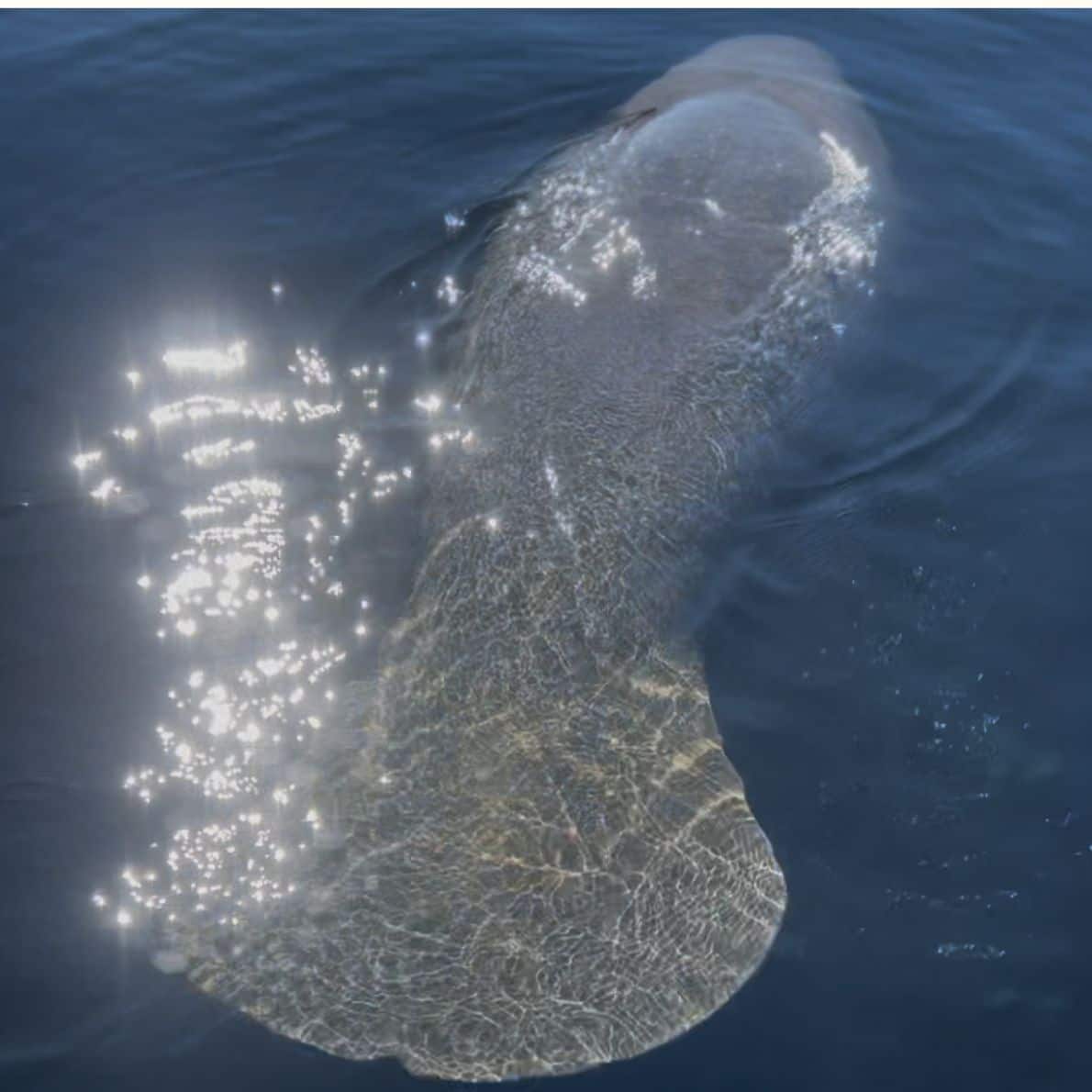
Table of Contents
- Meet the Florida Manatee – AKA Gentle Giants
- Florida is a Winter Refuge for Gentle Giants
- Manatee Season: The Perfect Time to Visit Florida’s Springs
- Why Florida’s Springs Are the Place to Be
- Where to Go: Top Manatee Viewing Spots
- Snorkeling and Paddling: Choose Manatee-Safe Guides
- Respecting Manatees: Enjoying Their World
- Take the Magic Home: Adopt a Manatee
- Protecting Manatees: Simple Tips for Visitors
- Manatees are Critical to Keeping Florida Springs Alive
- Protecting Manatees Means Preserving Memories
- Quick FAQ for Visitors
- Resources for Visitors
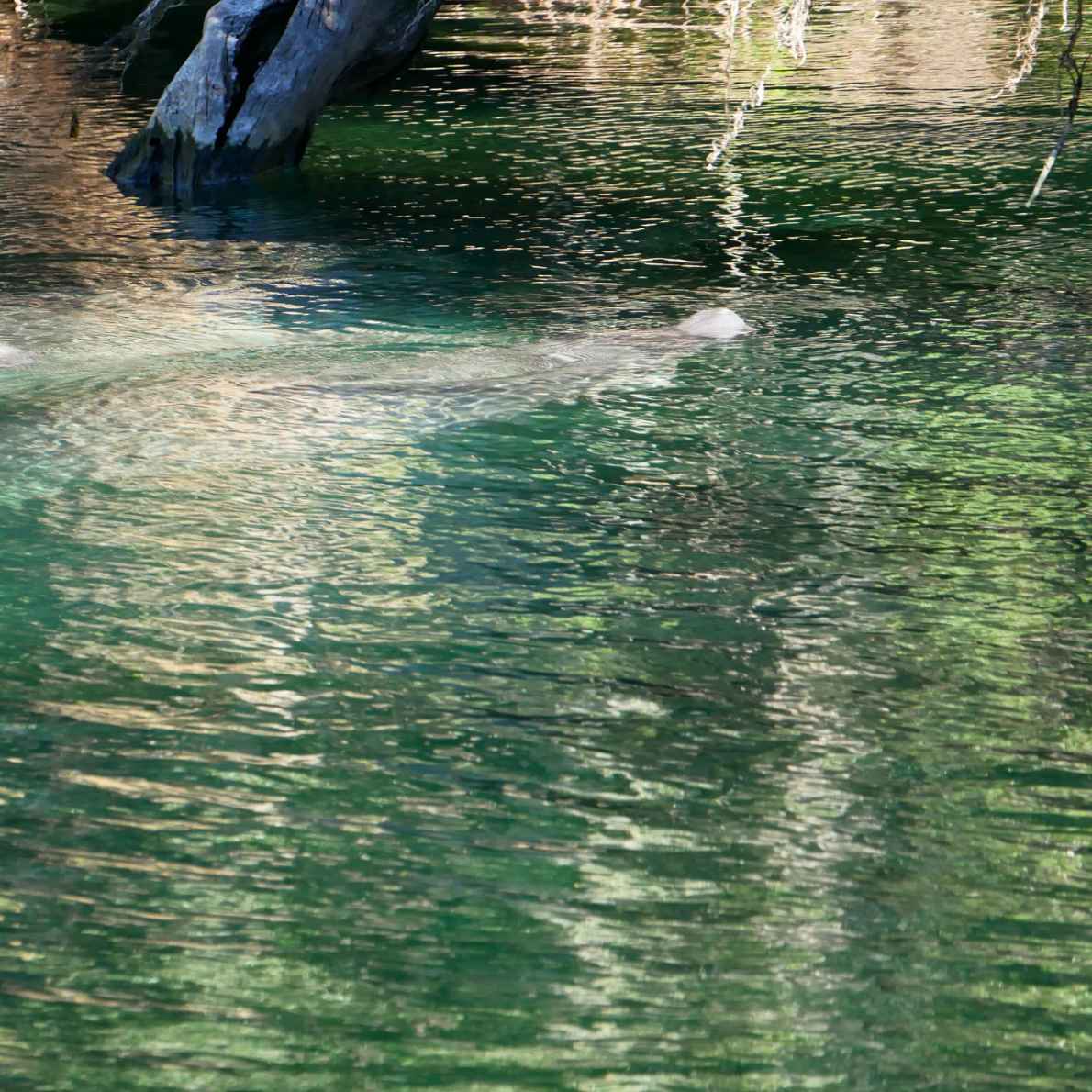
Meet the Florida Manatee – AKA Gentle Giants
Manatees are full of fascinating traits, starting with the sounds they make—chirps, whistles, and squeaks—especially between moms and their calves. These gentle giants are mammals, just like us, which means they need to breathe air. While they typically surface for a breath every three to five minutes, they can hold their breath for up to 20 minutes when they’re resting. And with their round, paddle-shaped tails, it’s easy to see why they’re often affectionately called “chubby mermaids!“
They’re also distant relatives of elephants and hyraxes (look up hyraxes—they’re fascinating little creatures!). Like their land-dwelling cousins, manatees have specialized teeth called “marching molars.” These teeth grow at the back of their mouths and gradually move forward as the front ones wear out and fall out. Their hearts are another wonder, beating at a steady 50 to 60 times per minute. And when two manatees touch noses, it might be their version of a kiss—a tender way to communicate with each other.
Manatee moms usually have just one calf at a time, with twins being extremely rare (only about 1% of births!). Despite their calm reputation, manatees can move quickly when they need to, reaching speeds of up to 20 miles per hour in short bursts. Most of the time, though, they’re content to cruise through the water at a relaxed three to five miles per hour, embodying a peaceful pace of life that perfectly matches their surroundings.
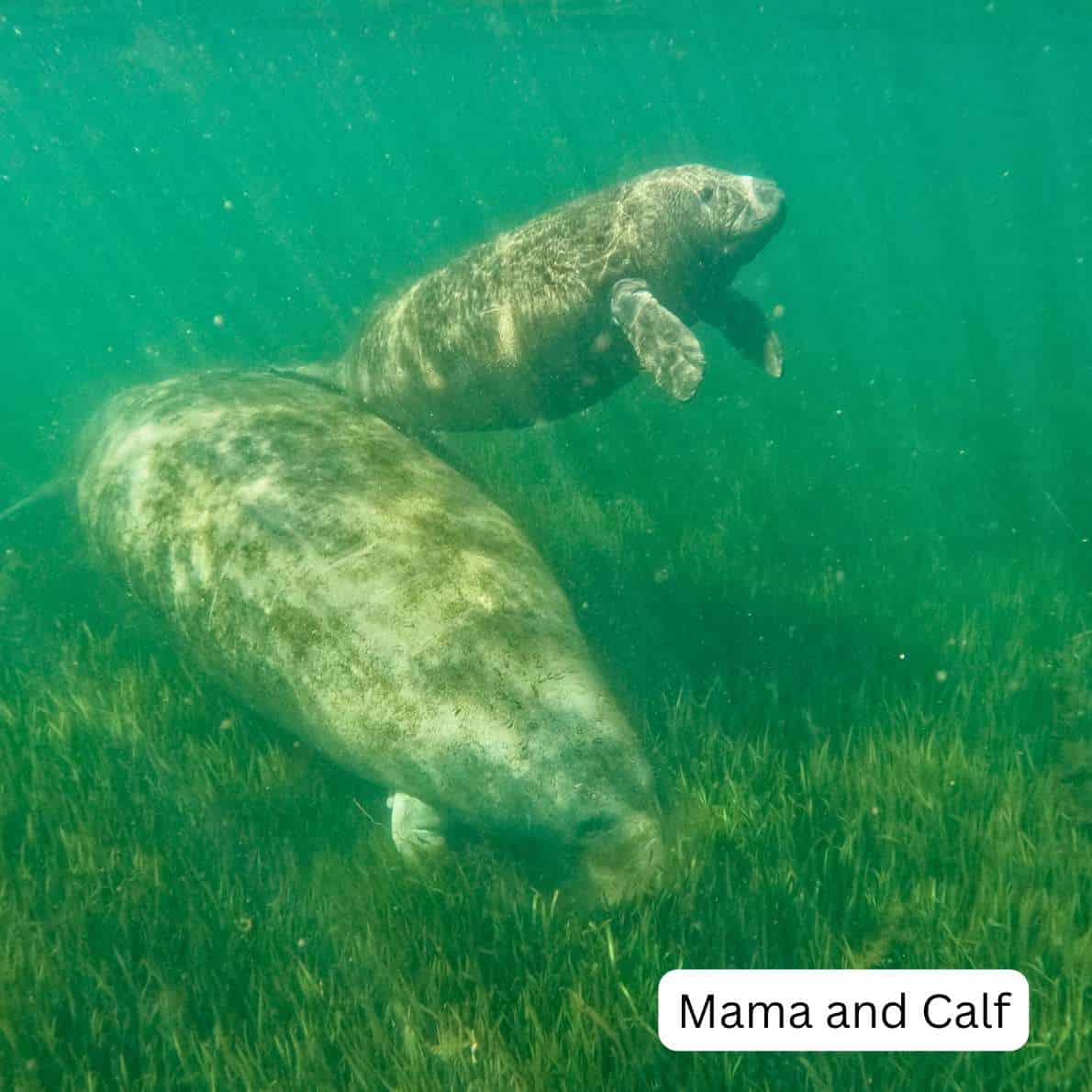
Florida is a Winter Refuge for Gentle Giants
Every winter, manatees seek the warmth of Florida’s springs, where the water stays a constant 72°F. These springs are a lifeline for manatees, protecting them from cold stress, a condition similar to hypothermia. Watching manatees glide through the clear water, resting and feeding, is a sight you won’t forget. But if manatees lose access to these warm refuges or their habitats are harmed, they can’t survive. Springs and waterways rely on manatees to maintain their health, biodiversity, and unique beauty.
Manatee Season: The Perfect Time to Visit Florida’s Springs
If you’ve ever dreamed of seeing manatees up close, winter is the time to visit Florida. From mid-November to end of March, manatees gather in large numbers in the state’s warm springs to escape the cold waters of the Atlantic Ocean and Gulf of Mexico. This seasonal migration is what makes “manatee season” so special—it’s a chance to witness these chubby mermaids in their natural habitat.
While manatee season officially runs from November 15th to March 31st, the timing can shift depending on the weather. If temperatures drop earlier than expected, manatees instinctively seek out warmer waters sooner. Similarly, if Florida experiences unseasonably warm weather during winter, manatees might temporarily leave their refuges. But don’t worry—they’ll return to the springs as soon as the temperatures dip again, making winter the best time to see these incredible creatures.
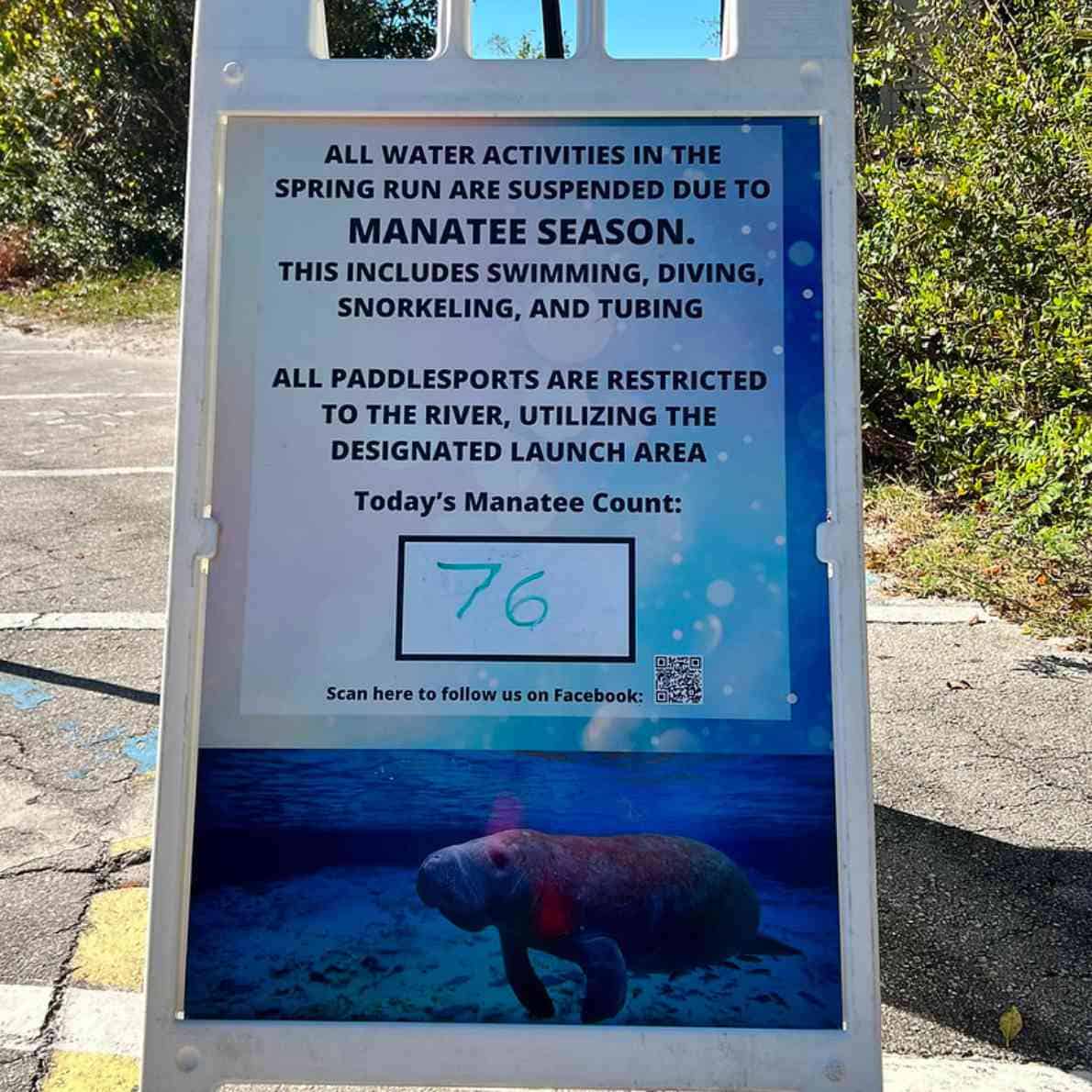
Why Florida’s Springs Are the Place to Be
Florida’s springs are as beautiful as they are crucial for manatees seeking warmth, rest, and nourishment. Two distinctive rivers and spring systems deserve special mention:
- Crystal River (Gulf Coast): This area is a manatee paradise. A network of springs flows into Kings Bay, which connects to the Crystal River and then winds through tributaries to the Gulf. This natural system is ideal for manatees seeking refuge, and visitors flock here to experience the magic of seeing manatees gather in clear, turquoise waters.
- St. Johns River (Atlantic Coast): On the opposite side of the state, the St. Johns River serves as a vital pathway for manatees migrating inland. Stretching 310 miles from Vero Beach to Jacksonville, this massive waterway connects to several warm springs where manatees find shelter during the winter.
Where to Go: Top Manatee Viewing Spots
Popular spots like Blue Spring State Park, Three Sisters Springs, and Silver Springs State Park offer incredible opportunities to observe manatees in their natural habitat. Whether you’re strolling along a boardwalk, paddling alongside them, or enjoying a glass-bottom boat tour, there’s something for everyone.
If you’re looking for additional places to go (because springs aren’t the only places!), I mention them all in my guide to the best places to see manatees during the winter.
When planning your visit, pack binoculars, sunscreen, water, and a camera to capture the magic. And remember, Florida mornings can be chilly in winter, so bring layers to stay comfortable. With a little preparation, you’re in for an unforgettable manatee experience that connects you to Florida’s natural beauty.

Snorkeling and Paddling: Choose Manatee-Safe Guides
For those looking to snorkel or paddle with manatees, it’s important to choose companies that prioritize their safety and well-being. Save the Manatee Club’s Guardian Guides program highlights tour operators who have been educated on manatee-safe practices, ensuring a respectful and memorable experience for visitors.
If paddling is your style, Get Up and Go Kayaking is an excellent choice. Recommended by Save the Manatee Club, they lead guided tours throughout Florida in clear kayaks, giving you an incredible view of manatees below while ensuring their safety. Their knowledgeable guides make sure both kayakers and wildlife are cared for, creating an experience you won’t forget.
For snorkeling, Crystal River Watersports and Manatees in Paradise are two highly recommended companies and are also recognized by Save the Manatee Club. Both offer manatee snorkeling tours that balance an up-close experience with responsible practices. I snorkeled with manatees several years ago, and it was truly life-changing. If you’re able to include this in your visit, I can’t recommend it enough—it’s the kind of gift you give yourself that you’ll treasure forever.
By choosing companies committed to manatee-safe practices, you’re not only creating unforgettable memories but also helping protect the manatees and their habitats for generations to come.

Respecting Manatees: Enjoying Their World
Swimming or paddling with manatees is a unique and unforgettable Florida experience, but it’s important to remember—they’re wild animals, not pets. Treating them with respect ensures they stay safe and undisturbed while allowing you to enjoy their presence responsibly.
How to Be a Respectful Visitor
- Give Them Space: Stay at least two kayak lengths away while paddling or one body length if you’re in the water. Let them approach you if they’re curious—never chase or block their path.
- Look, Don’t Touch: Watching manatees is incredible, but touching, riding, or holding onto them is harmful and against the law.
- Keep It Quiet: Avoid splashing or making loud noises, which can scare or stress them.
- Skip the Snacks: Manatees get all the nutrients they need from plants, so don’t feed them or offer them water.
- Respect Sanctuary Areas: Stay out of zones designated for manatee protection—they’re safe spaces for them to rest and feed.
Manatees are wild and protected under federal and state laws, so any actions that harm or disturb them can result in penalties. But more importantly, respecting these creatures ensures that they will thrive in their natural habitat, giving everyone the chance to experience their magic in the future. By following these simple tips, you’ll make your visit memorable and help protect Florida’s manatees for future generations.
Take the Magic Home: Adopt a Manatee
Seeing manatees in Florida’s clear springs is one of those moments that stays with you—peaceful, magical, and uniquely tied to this special place. That connection doesn’t have to end when your visit does. By symbolically adopting a manatee through Save the Manatee Club, you can preserve the memory of your experience while helping to protect these sweet potatoes for years to come.
When you adopt a manatee, you’re supporting efforts to rescue and rehabilitate injured animals, protect their habitats, and fund important research. Along with the adoption, you’ll receive a photo, biography, and updates about your chosen manatee, giving you a personal connection to the sea cows you encountered. It’s like bringing a piece of your Florida adventure home with you—a unique and lasting souvenir that keeps the magic alive.
Adopting a manatee is more than just a memory—it’s a way to carry a piece of Florida’s magic with you. Each update about your adopted manatee connects you to those tranquil waters, the awe of seeing them glide gracefully through the springs, and the wonder of sharing that moment with those you care about. It’s a quiet reminder of the beauty you experienced and a way to inspire others with the story of Florida’s sea cows. Through this small act, you become part of their story and help protect the place that made your visit so unforgettable.
Protecting Manatees: Simple Tips for Visitors
Manatees are a beloved part of Florida’s wildlife, but they face serious challenges due to human activity. As a visitor, there are easy steps you can take to enjoy Florida’s waterways responsibly, whether you’re boating, fishing, or simply observing these chubby mermaids.
Precautions When Renting a Boat
If you’re renting a boat, especially a motorized one, it’s essential to follow a few key precautions to keep manatees safe:
- Follow No-Wake Zones: These zones, often marked with signs, are slow-speed areas where manatees are known to swim. For example, the intersection of the St. Johns River and Blue Spring State Park’s spring run is a no-wake zone to help prevent boat strikes. Always reduce your speed and stay alert in these areas.
- Stay in Deeper Waters: Manatees often rest or feed in shallow areas, so avoid cutting through shallows whenever possible. If you see a manatee, give it plenty of space to move freely.
- Keep a Lookout: Manatees can be hard to spot, but look for their telltale snouts when they come up for air or the swirls they leave behind in the water. Slowing down and being vigilant can prevent accidents.

Fishing Responsibly
Fishing is a favorite pastime in Florida, and you can enjoy it while protecting manatees and their habitat:
- Use Designated Fishing Line Receptacles: Many fishing areas have special bins for disposing of monofilament lines and hooks. These can easily entangle manatees and other wildlife, so always make sure to put them safely in the receptacles.
- Avoid Littering: Discarded plastics, bait containers, and other trash can harm manatees. Pack out everything you bring.
- Be Mindful of Nearby Wildlife: Never attempt to hook or catch a manatee, and avoid fishing in areas where manatees are resting or feeding. Respect their space to keep them safe.
Manatees are Critical to Keeping Florida Springs Alive
Manatees don’t just live in Florida’s springs—they help keep them thriving. These herbivores graze on seagrass and freshwater plants, preventing overgrowth and ensuring sunlight reaches underwater ecosystems. They even control invasive plants, like floating water hyacinth, that can choke waterways. Their natural “gardening” creates healthy habitats for countless species, from fish and seahorses to crabs and birds. If manatees were to disappear, entire ecosystems would be at risk, and the springs would lose much of the life and vibrancy that make them so special.
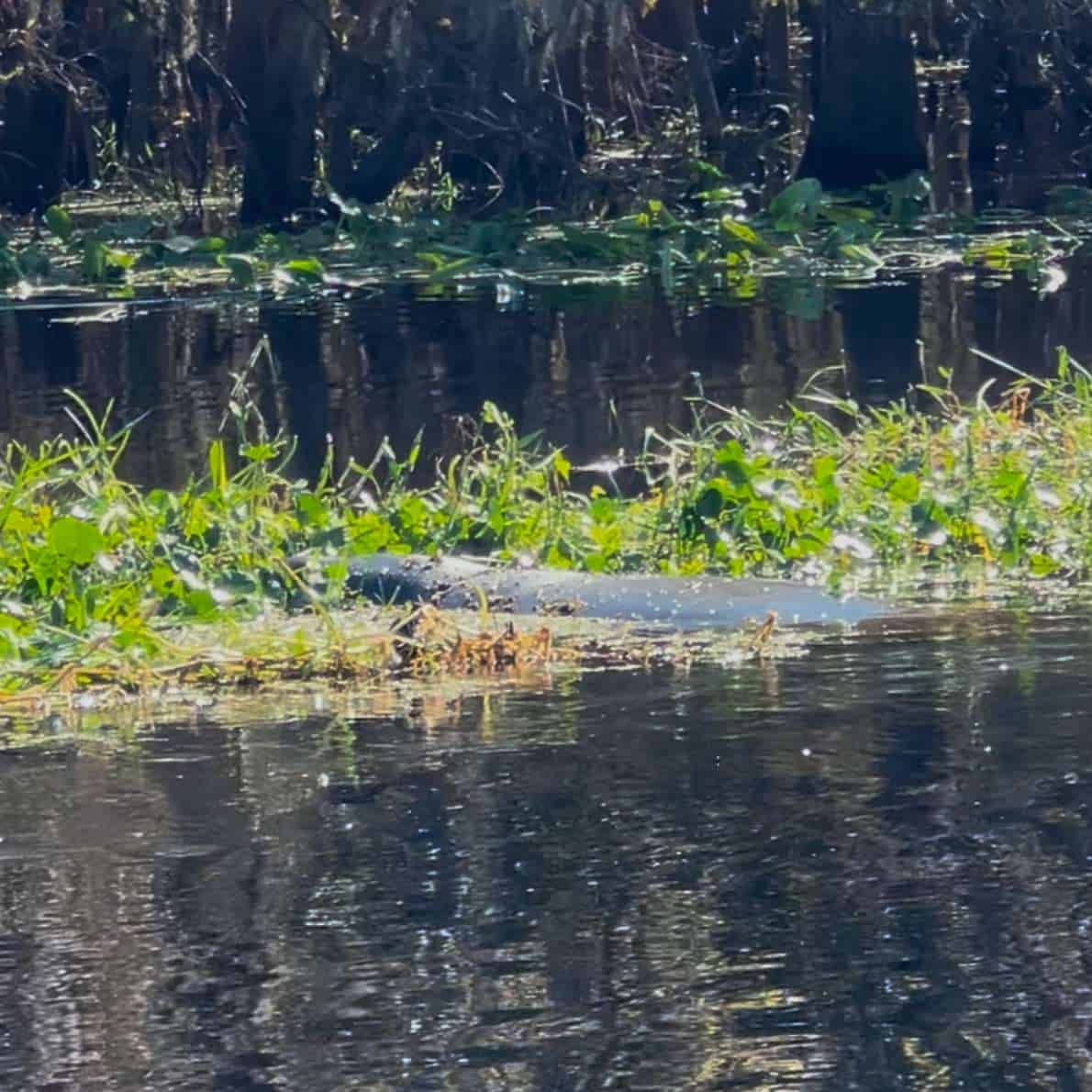
Protecting Manatees Means Preserving Memories
Think about your favorite moments—watching a manatee swim beside your kayak, spotting one from a boardwalk, or sharing that wonder with your family. Now imagine those experiences disappearing. If manatees vanish, so does a piece of what makes Florida’s springs unforgettable. By helping protect manatees and their habitats, you’re ensuring that future visitors, including your loved ones, can continue to enjoy the magic of these sweet potatoes. Safeguarding manatees means safeguarding the beauty and memories that make Florida’s springs worth visiting.
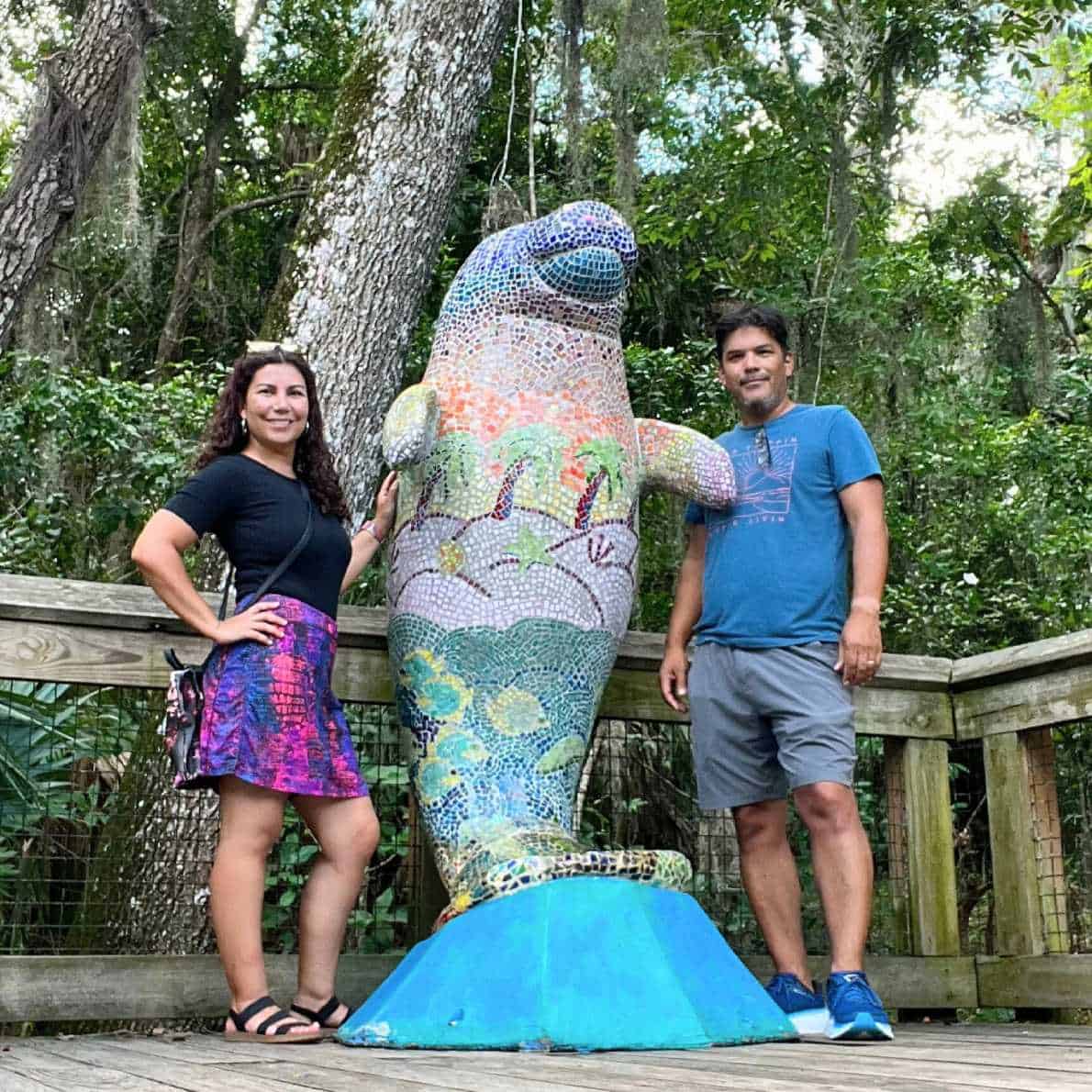
Quick FAQ for Visitors
- When is the best time to see manatees?
Winter, from mid-November to early April, is when manatees gather in warm springs. - Where can I see them?
Top spots include Blue Spring, Three Sisters Springs, and Silver Springs State Parks. - Can I swim with manatees?
Yes, in areas like Crystal River, but always observe them respectfully. - What should I bring?
Layers for cool mornings, sunscreen, water, binoculars, and a camera. - How can I help protect manatees?
Follow posted signs, keep your distance, and avoid loud noises or splashing.
Resources for Visitors
Adopt a manatee and learn more about them at SaveTheManatees.org.
Learn more about visiting Florida springs.
Best springs for seeing manatees:


Manatees are so iconic to Florida! I was bummed I didn’t see one during my week long visit, but then again I had no idea where to look haha. Thanks for all these wonderful suggestions, I’m SUPER PREPARED for next time!!
That is a bummer, but it just means you need to go back!
I had JUST missed the manatees when I went to Florida, but I am definitely preparing for the next time I visit. Thanks for sharing!
Yes, you definitely need to come back to see them!
Really great post, Jessica! Tons of amazing information and beautiful pics of our manatees.
Thanks Cris!
Love seeing manatees in Florida, though we’ve seen most in the canals in Miami. I’d love to spend some time at the springs seeing more of them.
Sonia, I love that you have seen them!
Thanks for this very informative post. It really makes me want to visit Florida to see them.
You need to Barbara! You won’t regret.